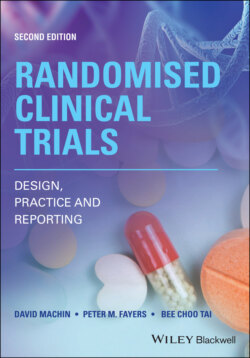Читать книгу Randomised Clinical Trials - David Machin - Страница 59
2.8 Making the assessments
ОглавлениеIn the simplest situation, once the patient has been checked for eligibility, some basic demographic and clinical variables recorded, consent has been obtained, randomisation activated, treatment commences and is completed within a short time span. If the trial endpoint is also defined to be observed within a relatively short time frame, the whole trial can be of very short duration and the data collection process should be relatively straightforward. Such a short‐term situation could arise in a trial to study the immediate postoperative pain relief provided by certain types of rapidly acting analgesics. However, most trials are more complex than this. For example, in many situations, the period of treatment may be extensive and perhaps differ for each intervention and vary from patient to patient. In trials concerned with approaches to wound healing, the time to satisfactory closing of the wounds will vary and very detailed monitoring of the wound may be needed to determine when the outcome is indeed satisfactory. Further some considerable time may be required before the endpoint can be determined, for example, trials testing potentially curative therapy for early prostate cancer might have to follow patients for more than a decade before any difference is detectable in an outcome such as survival. Thus, the trial design must stipulate carefully exactly when assessments are to be made and the criteria used for determining the endpoint meticulously documented within the trial protocol.
